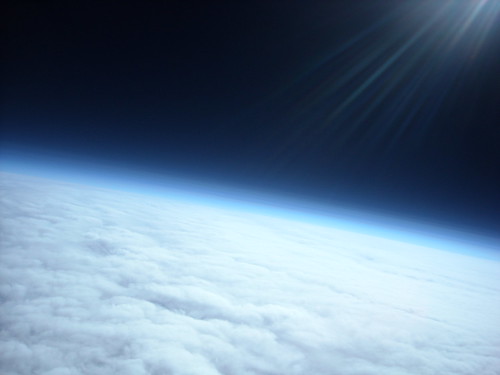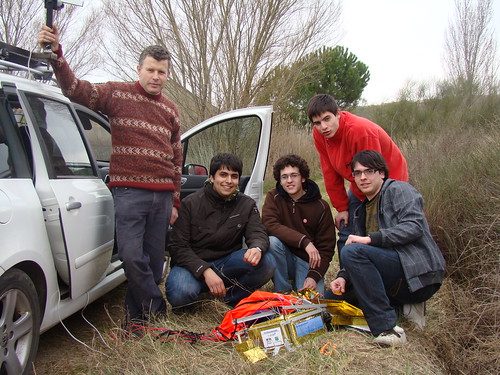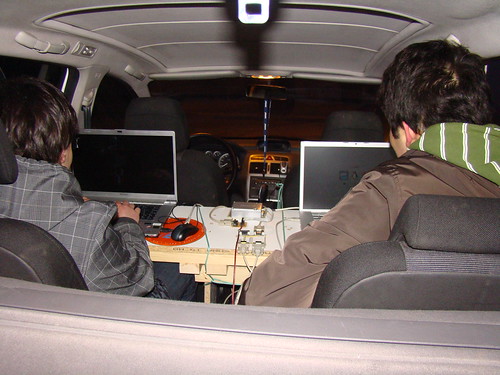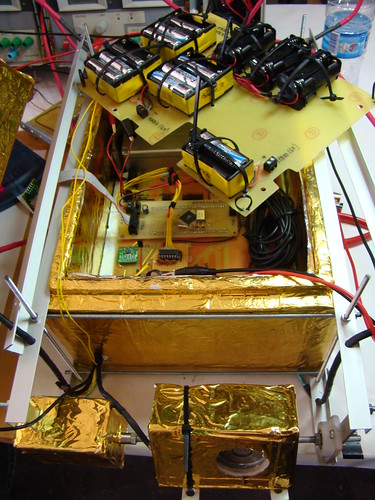Every time I see projects like this, it makes me want to buy a large tank of helium. Meoteotek was a project put together by a group of students to launch a data logger into the lower atmosphere. I am unable to translate Spanish Catalan, but pictures have a way of speaking for themselves.
This team emailed us to let us know that the Copernicus GPS module and the SCP1000 pressure sensor performed admirably at 30,677m (100,000ft)! I love that they used a brick of AA batteries. I would have used a LiPo (lighter, better capacity). Do alkaline batts hold up better under cold temperatures than LiPos? There's a good video of the preparations and launch.

So cool. Can we even do this in paranoid America? Can I just find an open spot in Kansas and launch a payload to 100,000ft? There must be clearance or something I have to get from the FAA? I think we should have an autonomous payload rendezvous competition next year.

It looks like it was a successful launch and recovery. Congrats guys! Awesome project!









I think I read somewhere that the regulations are different between Europe and the US. In the US you can pretty much whenever you want. As others have pointed out, you must stay below a certain weight.
In Europe, you need permission for each flight before launch.
Some people are afraid that these balloons can collide with an aircraft, but chances that this happens are pretty small. Weather stations launch balloons pretty often.
Interesting fact: A weather balloon on the ground (filled with helium) has a diameter of ~4 meters. At 10km height, it has expanded to 20 meter (5 times bigger). A balloon can have a diameter of 40 meter before it explodes.
I fly these in Europe (the UK) as a member of CU Spaceflight
http://www.cuspaceflight.co.uk
You don't need permission before each flight in a strict sense, but the CAA will allow you a NOTAM (notice to airmen) to launch with, and you just phone up the local control tower before launches to inform them that you're going to launch.
The biggest latex weather balloons commonly used (3kg) have a Burst Diameter of 13m. they are maybe ~2m on the ground. I am not sure where you got your numbers from, but if a balloon is 4m dia on the ground, and 20m dia at 10km, that is a volume increase of 5^3 = 125 times. This implies the atmospheric pressure at 10km is ~1/125th sea-level pressure. This is completely incorrect - it is more like 1/4 sea-level pressure.
I got my information from a Dutch Wikipedia about weatherballoons: http://nl.wikipedia.org/wiki/Weerballon
[quote]Een gewone met helium gevulde weerballon die op de grond een diameter van circa 4 meter heeft, heeft op 10 kilometer hoogte een diameter van 20 meter! De ballons zijn hier echter op berekend en kunnen zelfs een doorsnede van meer dan 40 meter bereiken voordat het materiaal scheurt[/quote]
Translated by Google:
A simple helium-filled weather balloon on the ground a diameter of about 4 meters, 10 kilometers to a diameter of 20 meters! The balloons are, however, calculated and even a cross-section of more than 40 feet before the material breaks
did you rate me negative for this? If I am incorrect, Wikipedia is incorrect (which I highly doubt).
You highly doubt Wikipedia is incorrect? How Ridiculous! Just do the maths! To trust a block of text written by some random guy over the compelling simplicity of some basic sums is astonishing. Shame on you!
I did note rate you negative either, I didn't even realise such a feature existed. However maybe I should because you're putting your faith in Wikipedia.
High Altitude Ballooning Forum
The Trackuino! HAB Tracker
It is great!
I did this a couple years back. So long as you abide by regulations in the FAR regarding balloons and file a NOTAM (notice to all airmen) with the FAA, you can launch them. There's actually several groups in the U.S. that launch balloons regularly.
http://www.geocities.com/achilles03/balloon_pictures.pps
these are so nice pictures.i have ever not seen in my life that kind of cloud picture.
electronics
I would totally be down for an autonomous payload rendezvous competition next year.
It would be cool if after the balloon popped you could get the payload to fly back to its starting GPS coordinates.
You can check my website, nearsys.com, for links to my book (free and online) and the articles I write for Nuts and Volts concerning near space. Some of the stuff I use for near space exploration comes from Sparkfun.
I'm working on a series of articles for the Society of Amateur Scietists about BalloonSats that wil end up as a book (I hope by the end of the year).
Some of these amateur radio, high altitude balloon launchers (like me) do travel and will launch for other groups.
Onwards and Upwards,
Paul
JP Aerospace has been offering a high altitude balloon launch service to the public for a long time:
http://www.jpaerospace.com/
Hundreds of elementary school kids through adults have sent up payloads via the "pongsat" (has to fit in a ping pong ball) program. They don't charge for this. You can also buy larger payload space.
This is perfect for Sparkfun experimenters.
My kids and I have participated in several missions. They have sent up marshmallows. I have sent up temperature loggers. Perfect for science fairs for the kids or an excuse to buy Sparkfun type stuff for the adults.
We have had mixed results -- sometimes you wait a long time or the balloon doesn't reach full altitude, once they didn't recover the payload. But the vast majority of their flights have been successful.
They mail you back your pongsats and a lot of documentation on the flight.
John (JP) is a great person to deal with, he and his volunteers are providing a great service. We usually make a donation or buy an ad to help them out.
Highly recommended if you are interested in a project like this.
Very cool project!
A number of the posts above mention LiPo batteries. Please think twice before doings so. LiPo cells can be damaged, especially on landing should something go wrong (like your parachute get tangled). As many of you know, LiPo cells can easily start a lithium fire when damaged and unlike most uses, you are not usually close enough to deal with any problems. Depending on the weather and location, it can be hours, days, or you may never actually locate the payload.
The Energizer L91 Batteries used here are safe and work well with the cold. If you need rechargeable, standard Li-Ion metal cells will be a better than the plastic LiPo cells, but the by far the best bet is using LiFePO4 cells that are much safer to use.
http://en.wikipedia.org/wiki/Lithium_iron_phosphate_battery
Theoretically, you're not supposed to fly balloons in USA because you're supposed to be buying houses.
Balloons are regularily launched by many groups. Check http://www.arhab.org/ for future launches and follow along at home in real time using APRS. Great fun, but do your reasearch and leave nothing to chance, such as what gps to use. Most have an altitude limit and stop working at, or before, 65K ft so a list of those known to work is kept at http://showcase.netins.net/web/wallio/GPSrcvrsvs60kft.htm . And for a page with photo's to 117,597ft, see http://bear.sbszoo.com/sable/sable3.htm
To add one more link to a related project: The high-altitude glider project should be of interest to you guys. They tied an R/C plane to a balloon, sent it into the stratosphere, and the plane then glided back to earth on autopilot.
http://members.shaw.ca/sonde/
See also this project:
http://speed.vpizza.org/~jmeehan/balloon/
He has a section in the write-up about the FAA regulations on this sort of experiment.
Check out EOSS (edge of space sciences):
http://www.eoss.org
They are a local organization that flies balloons. Their site is really helpful. They have links for hardware, and software and they have pictures of many of their systems.
Flight Regulations:
http://www.eoss.org/pubs/regulations.htm
The batteries are lithium primary cells that behave well under heavy loads and at low temperatures, and are about half the weight of alkaline cells. We use them on all our balloon flights. The voltage drops more than the data sheet implies at -40C, but they do work well in the cold. LiPo may beat them for energy density, but certainly not for simplicity.
The FAA regs for a balloon ("unmanned free balloon" in their terminology) are pretty easy to meet if you fly the <12lb total payload string <6lb in any one package on a latex balloon during daylight hours, but my understanding is that they are decidedly unfriendly toward AAVs, so autonomous rendezvous is out.
goto:
http://www.ansr.org/
which is "Arizona Near Space Research".
They do ballooning in your neck of the woods (at least compared to where I live near Cleveland).
Gary
Looking at the picture I'm relatively certain that's actually a block of energizer lithium-ion batteries. Sure, LiPo would have been a bit lighter, but have you every tried holding a pack of alkalines and a pack of lith-ion AA batteries? They're REALLY light.
if you look at this picture you will see that they are lithium battery
http://www.flickr.com/photos/meteotek08/2515528215/
You have the AA ultimate lithium
http://data.energizer.com/PDFs/l91.pdf
and the AA advanced lithium
http://data.energizer.com/PDFs/ea91.PDF
Ultimate lihitum = 2A max discharge shelf life of 15 years
Advanced lithium = 1,5A max discharge shelf life of 10 years
They both have operating temp of -40?C to 60?C (-40?F to 140?F)
I believe those AA-batteries are Energizer "Lithium" kinds, and not ordinary alkalines.
I'm not quite sure about the difference, but they are supposed to be operating without problem down to -40 celsius. They are also slightly lighter than ordinary AAs, and have 3000mAh capacity.
"I am unable to translate the Spanish..."
Me neither!!
While my native language is Portuguese, I could recognize this is not Spanish. I guess it is Catalan...
BTW, great project. Add some propellers, an IMU, and you can try to bring it back...
I guess just a GPS would be fine and cheaper by the way !
Nice,
Of course you'll have trouble to translate as it's in catalan and not spanish! lol
Bon treball!
I was curious, so Google to the rescue :) Black text on black background is a bummer, but a copy+paste or just a select all makes it readable.
http://translate.google.com/translate?prev=hp&hl=en&u=http://teslabs.com/meteotek08/&sl=ca&tl=en
The first high-altitude project I remember seeing is the Pegasus I. IIRC, that project attached radar reflectors to the payload as per some FAA regulation.
You can do this in america without filing with any government agency as long as the entire flight string is less than 12lb and any individual payload is less then 6lb.
Here are some photos from a launch we did in Kentucky
http://www.flickr.com/photos/autography/sets/72157606172224525/
http://ideasvn.ece.engr.uky.edu/pics/gallery2/main.php?g2_itemId=16357
Nice job guys.
P.S. Chasing and finding the balloon after descent is the most fun you will have in a while.